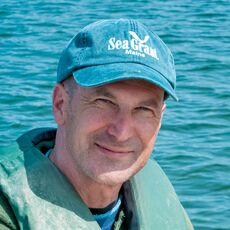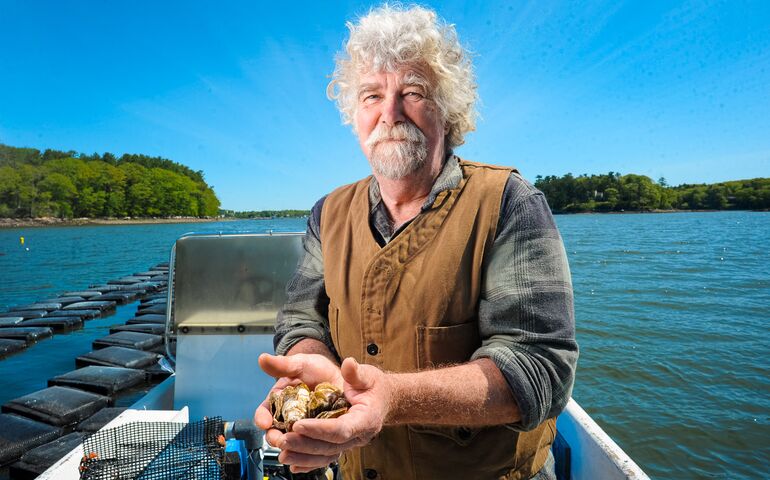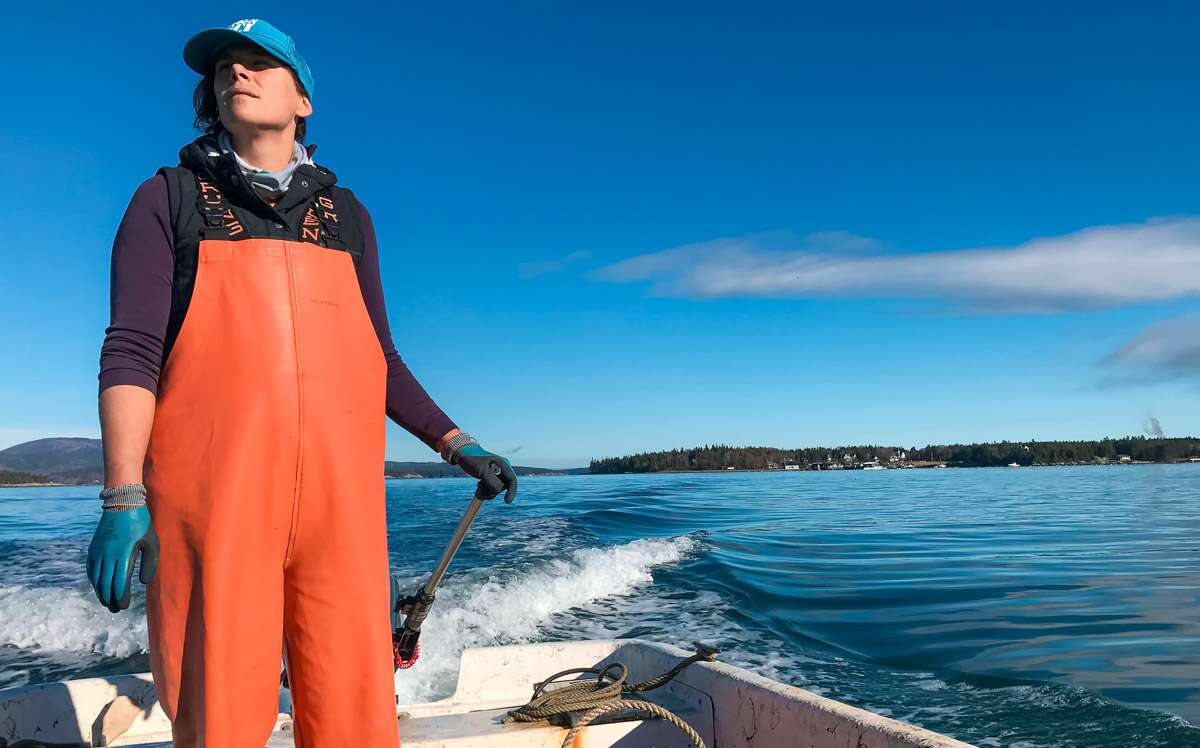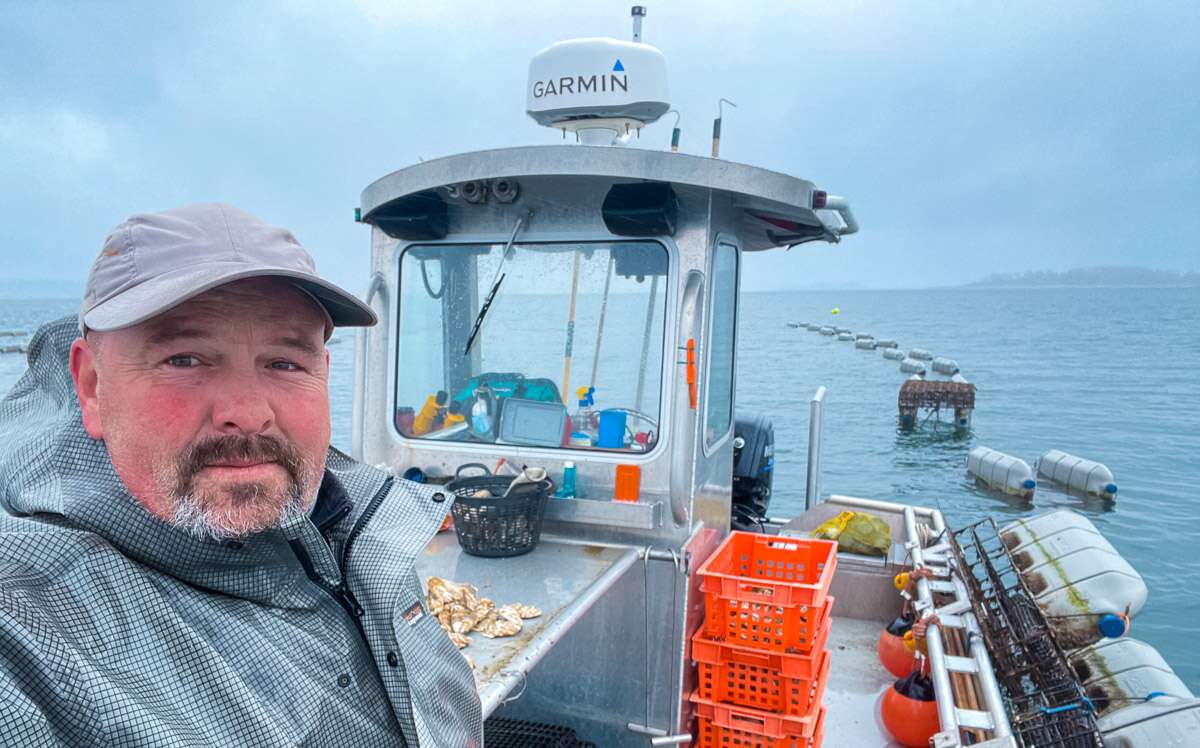
This world is your oyster: A robust oyster farming industry thrives — despite hard work and nature’s wily ways
 Photo / Fred Field
Smokey McKeen, co-founder of Pemaquid Oyster Co. in Bristol, was an oyster farming pioneer who helped establish the industry in Damariscotta in the 1980s and is still going strong
Photo / Fred Field
Smokey McKeen, co-founder of Pemaquid Oyster Co. in Bristol, was an oyster farming pioneer who helped establish the industry in Damariscotta in the 1980s and is still going strong
In 1986, Pemaquid Oyster Co. in Bristol was one of only a few oyster farms in Maine.
“One of my friends said it was like belonging to a country club but, instead of going golfing on a Saturday, we’d mess around on the river,” says Smokey McKeen, who started the farm with fellow aquaculture enthusiasts Chris Davis and Carter Newell.
“At some point we had to treat it more like a business,” he continues. “It’s been fun to see the industry grow.”
From just a few operations 40 years ago to about 150 oyster farms today, the industry has grown indeed. Farms extend from York to Washington counties and raise millions of oysters per year for the white tablecloth market, according to the Maine Aquaculture Innovation Center.
Not for the faint of heart

Today, millions of oysters are produced yearly; most farms have a handful of employees, bigger ones employ a couple of dozen. Most oysters go outside Maine. Traditional markets include New York, Toronto, Chicago and Atlanta. Maine is well situated for distribution, being a 24-hour truck ride from 150 million consumers, notes Dana Morse, the aquaculture lead for Maine Sea Grant and University of Maine Cooperative Extension, based at the Darling Marine Center in Walpole.
People participate in the industry from the hobby scale to a full-time career. “But it is farming – it’s risky, it’s uncertain, it’s really hard work, it’s difficult on your body,” Morse says. “And nature definitely has a very big say as to what’s going to happen or not going to happen.”
He adds, “It’s not necessarily for the faint of heart.”
Attributes that make Maine great for the industry include varied coastal systems – with attributes such as optimal water temperature and enough food – that suit the animal’s biological requirements, says Morse.
Maine’s regulatory environment is conducive to allowing entrants at different scales.
“We have a system that is fairly robust,” he says. “It seems to be viewed as relatively fairly balanced between opportunities for business and the responsibility for conserving and using public spaces.”
Maine’s training programs, such as the University of Maine’s Aquaculture in Shared Waters program now in its 10th year, have helped grow the industry.
“The market has been very strong,” Morse says. “Pretty much every grower can sell what they can grow at a pretty reasonable price and, in some cases, very good prices.”
Early pioneer
An earlier wave of farms grew European oysters in the midcoast in the late 1970s. Factors such as disease and susceptibility to Maine’s cold winters prevented the species from taking off.
In the mid-1980s, McKeen and other farmers experimented with growing American oysters on the Damariscotta River. The river’s clean, salty and nutrient-rich water was ideal. And it was home to the University of Maine’s Darling Marine Center, which was instrumental in establishing shellfish aquaculture thanks to a research program, established by a resident researcher, Herb Hidu.
Hidu encouraged would-be farmers to try American oysters, native to the region. There were no textbooks on how to do it. “We were building our own gear,” recalls McKeen. “We’d meet on the weekends and mess around on the river.”
McKeen and his partners settled on a technique to grow oyster seeds — tiny babies — in cages floating on the surface, then broadcasting them on the bottom when they reached a certain size. After a year, they’d drag up a marketable crop.
The first year, they planted 250,000 seeds. Today, they plant about 2 million seeds per year, selling through wholesale and retail channels. Three years ago, McKeen and his wife opened a restaurant, the Oysteria, in Bristol, featuring Pemaquid Oysters. Pemaquid has three full-time employees plus the three partners.
Gear includes a lobsterboat to drag oysters, work skiffs and rafts. From overseas growers, they learned to store market-size oysters in holding cages, attached to rafts closer to the mouth of the river, where the deeper, saltier water optimizes the flavor and appearance.
“It doesn’t take a huge investment to get into it,” says McKeen. “When we started, we kicked up a couple of thousands dollars, went to our local sawmill, bought lumber and started building cages.”

Helping hands
That entrepreneurial spirit drives Lauren Gray, who started Cranberry Oysters off Great Cranberry Island in 2015 with 25,000 seeds. Her husband runs a boatyard, so she had heavy equipment and waterfront access.
Initial sales went to local restaurants. Sales have doubled each year for the past three years. This year, she’s planting 350,000 seeds.
Challenges include navigating the regulatory process. The leasing process is difficult to navigate. “It’s extensive, it involves a lot of work and a lot of skills, like mapping,” Gray says.
The process, established by the state, is reasonable, she adds. “But I think people think you just fill out a form. That’s not at all true,” she continues.
As Morse notes, nature also has its say. Gray’s cages are in a shallow site — great because the water warms to a good growing temperature, but difficult to sink gear for protection from winter conditions.
When pancake ice came through late last year, “it picked up a whole line of my cages and dragged it through probably four or five more lines of oysters, picking up a mooring rock and wrapping my pennant around it,” she says. “The ice is no joke. My cages were up on a ledge. You only have so much time to get out there, because if the oysters are exposed to freezing temperatures, they will die.”
Gray launched a boat, dragged the cages one by one off the ledge and placed them back on the bottom at low tide. A local diver suited up to make sure they were correctly oriented so the oysters weren’t in the mud, which could suffocate them.
Help from family and neighbors is part of the industry’s success. Gray’s in-laws helped build an oyster tumbler, which sieves and grades seeds or adults, and a float with a shelter.
Gray expanded to Portland outlets last winter and now has five part-time employees.
“This is my second year having a real crew,” she says. “When I was by myself and going out every day, I loved meeting the challenges. But now I have real help, I feel like I’m really starting to get somewhere. That has been huge.”
Beer summit
Thomas Henninger started Madeleine Point Oyster Farms in Yarmouth six years ago after working on commercial oyster draggers in southern New England and as a nurse in Maine. He and his wife have two sons and were looking for a way to include the whole family in a business.
Henninger spotted a growing cage one day. His training as a biologist and commercial fishing experience kicked in.
“The fireworks went off in my brain,” he recalls. “I said, ‘Here’s a way to grow oysters in a way that’s environmentally friendly. I instantly could see that this was something I could do with my boys.”
So he educated himself. “I got in my pick-up truck with a sleeping bag and basically went up and down the East Coast to find people doing it,” he recalls.
In New Brunswick, he noticed people in small boats doing surface farming. When they came in, no one was interested in talking with him, curtly responding in French.
“The next day, I showed up with a case of beer and, as they got out of their boats, I started tossing cold cans of beer at these guys,” he says with a laugh. “They grabbed them. Then I heard in perfect English, ‘What are you doing here?’ We started to talk. The next day, I’m out on somebody’s farm and learning how it works.”
Soon, he bought some grow cages, contacted Maine Sea Grant and Dana Morse, and took the Aquaculture in Shared Waters class.
Henninger selected three small sites off Yarmouth that were out of the way of other maritime users and had different characteristics, so he could test their efficacy. He shared the project with local biology classes and recruited students to help figure out optimal spots.
“They came up with all kinds of ways to test the rate of growth,” he says.
It wasn’t just about the fastest growing oyster, but also the tastiest — and the ability and sensitivity to work alongside other maritime users. Echoing the responsibility theme mentioned by Morse, Henninger says that, before applying for a standard lease site, he spent two years observing potential spots to make sure he wouldn’t be interfering with other maritime users, particularly commercial fishermen.
“As an oyster farmer, I need to communicate with lobstermen in the area, with scallopers in the area, with pogie fishermen in the area — and make sure that I’m putting my standard lease in a place that doesn’t keep them from their traditional spots,” he says. “And that’s absolutely possible. There’s more room out there than people think. But an aquaculturalist needs to take the time and the effort to find out who is fishing in that area.”

Trial and error
The operation unfolded with a lot of trial and error. “We learned as we went. We made mistakes. We killed a lot of oysters,” he says.
But, again echoing a common theme, Henninger found lots of help from others in the industry help each other out. Today, he has about 1.5 million oysters in cultivation and expects to sell about 100,000 this season.
“The first year, when I grew 300 or 400 oysters a week, I remember thinking I was the oyster king of the world,” he says. “Now it’s 6,000 oysters per week.”
The industry in general? “I see it growing in leaps and bounds,” says Henninger. “I see an incredibly diverse group.”
Still, “I don’t think there are many industries where the learning curve is as steep as it is here. We’re all learning all the time and we’re sharing our mistakes and our triumphs.”
Mainebiz web partners
A very fine article! You also want to thank DMR for its hard work in protecting Maine finfish and shellfish aquaculturists from having to test their crops for mercury, cadmium and other toxins commonly found in Maine's wild saltwater fishes & mollusks. This protects our growers from potential liability caused by inadvertently supplying chemically unhealthy food to consumers.









1 Comments